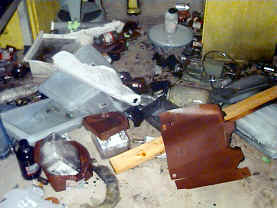When to Specify Flammable Refrigerators
There are many documented cases of severe damage due to explosions of volatile products stored in standard household refrigerators. The explosion is initiated when volatile fumes or products are ignited by sparks created by unit electronics such as internal lighting, thermostats, fans, and compressor cycling. In addition to property damage severe personnel injuries or even death can result when doors are blown off and contents scattered throughout the area. Attempting to make standard refrigerators into flammable refrigerators or flammable-safe refrigerators by removing potential sources of sparks not only will void warranties but also is definitely not the correct solution.
Flammable Materials Defined
According to OSHA, NFPA (National Fire Protection Association) and the International Building Code (IBC) a flammable liquid is any chemical with a flash point less than 100⁰F (38⁰C). Combustible liquids have a flash point greater than 100⁰F (38⁰C). An Indiana University Laboratory Safety Guideline* defines flashpoint as the minimum temperature at which a liquid gives off sufficient vapor to ignite in the presence of a source of ignition.
Flammable Refrigerator Construction
The key point is “a source of ignition.” Examples of sources are given in the opening paragraph of this post. The 24 cubic foot NSFR241 Nor-Lake Scientific flammable storage lab refrigerator available from Tovatech meets this criterion. It uses a mechanical cold controller and an internal chamber thermometer to control temperatures from 2⁰C to 10⁰C. The unit meets NFPA Class I Division 2 standards for storage of flammable solvents in closed containers.
So, while these Norlake manual defrost flammable lab refrigerators have no internal components that could cause a spark they do have the capability of maintaining close temperature control. Nevertheless lab personnel must be instructed to observe critical standard operating procedures, namely keeping all containers tightly closed and being certain that the container closure is adequate to prohibit the escape of volatile vapors. And by the way, using such containers does not excuse the use of standard household refrigerators.
For products that must be stored at temperatures from -10⁰C to -25⁰C Tovatech offers the NSFF 241 flammable storage laboratory freezer. This 24 cubic foot capacity manual defrost freezer is designed to conform to the same standards as the flammable refrigerator.
Explosion Proof Refrigerators and Freezers
If the atmosphere in the lab is volatile because of experiments conducted therein it is important to more thoroughly isolate equipment electronics from the lab environment. That is why explosion-proof units are hard wired into the building’s electrical grid rather than simply plugged in to a wall outlet. Thus the lab’s environment rather than the contents determines whether or not to select flammable or explosion proof equipment.
Contact the scientists at Tovatech for more information on specifying flammable and explosion proof refrigerators and/or freezers to comply with critical safety standards in the research lab. Potential personnel injury, death and severe physical damage to the facility when using substandard units is not worth the “cost savings” of modified residential refrigerators and freezers.
*Indiana University Laboratory Safety Guideline: Flammable Liquid Storage Properties, Classification, Quantities, Cabinets, Containers, and Refrigerators.

